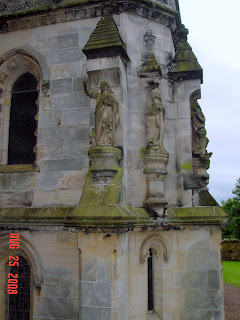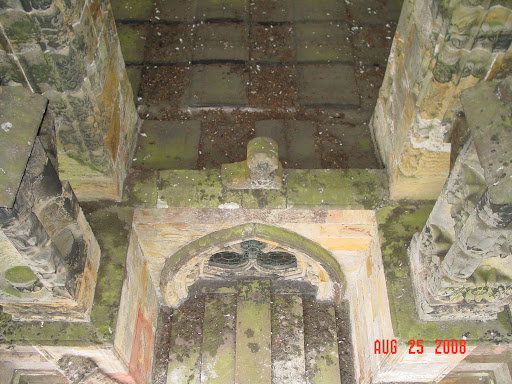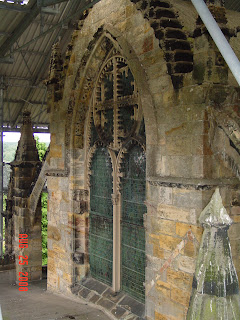Dan Brown’s Gift to the World
Rosslyn Chapel under heavy repair
Kathleen’s Carneil Farm B&B offered our last full Scottish breakfast which included kippers which are smoked herrings–superb!
The drive which skirted Edinburgh after we crossed the Firth of Forth took us into velvet-smooth green dales on a very drizzly morning under overcast skies.
Rosslyn Chapel–Dan Brown’s Gift to the World:
Our next destination was Rosslyn Chapel in the town of Roslin made popular in recent times as the final setting for Dan Brown’s book The Da Vinci Code. Though it has been a while since Llew and I had the book and watched the movie, I did remember many of the last parts of the plot that are shot in this chapel and decided that it was worth visiting. I had also read that the carvings inside are exquisite.
Getting there was no picnic what with the rain and the slick roads and the heavy traffic on the motorways. This was contrasted by a quiet one-lane country road that actually got us to the spot where we found the car park filled with tour coaches. It is a bank holiday in Great Britain and many people are out for the weekend. We paid the £7 entrance fee and found the place under heavy fortification with a large metal canopy concealing the roof.
 The history of the chapel goes back to the 1400s when it was constructed by William St. Clair. Over the years it has come to be associated with the Knights Templar and the secrets of the Holy Grail and the preservation of various precious items from the history of the Church including the scrolls from the Temple of Solomon. This sort of rumor gave rise to Dan Brown’s purely fictitious novel and has brought all the modern-day pilgrims seeking answers to the puzzles raised by his plot.
The history of the chapel goes back to the 1400s when it was constructed by William St. Clair. Over the years it has come to be associated with the Knights Templar and the secrets of the Holy Grail and the preservation of various precious items from the history of the Church including the scrolls from the Temple of Solomon. This sort of rumor gave rise to Dan Brown’s purely fictitious novel and has brought all the modern-day pilgrims seeking answers to the puzzles raised by his plot.
The carving is indeed exquisite, done in sandstone and featuring scenes from the Bible, the Seven Deadly Sins, the Seven Corporal Works of Mercy and two interesting pillars, one a square version, the other a rounded one with skeins encircling it. The former was said to have been carved by the Master mason, the other by his apprentice; but since the latter’s was better, the jealous master killed the apprentice. In many ways, the carvings inside the chapel reminded us of the sandstone temples we have seen in India in which the walls appear lace-like because the intricacy of the carvings is so closely wrought. Not surprisingly, Dorothy Wordsworth is supposed to have commented that the inside of the chapel reminded her of Brussels lace.
We went down to the crypt which also featured in the film only to find it empty and certainly not concealing the sarcophagus of Mary Magdalen! We had a superb half-hour lecture by a very good guide indeed and she filled us in on the history as well as the architecture of the chapel. We also climbed up the scaffolding that led us to the same height as the roof and the flying buttresses of the chapel—all being protected while the chapel is undergoing restoration—and found a very interesting perspective on the carvings from that height. We spent over an hour in that hallowed space and thought the visit was completely worthwhile. It is little wonder that when the book first came out, the chapel received 179,000 visitors in one day while today some 1000 visitors still come through each day.
The next leg of our travels took us into Northern England and the Yorskshire Dales. Please click on the link to follow us.

